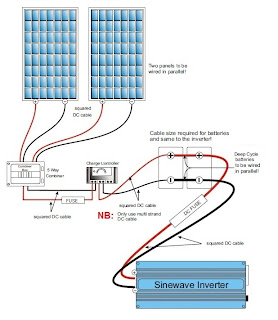They are having endless problems with the installation / installers of the wind turbine! The guy ropes keep slacking (that's because there are no lock nuts installed at the shackles), and not only are the batteries not charging properly, but the installation company apparently left absolutely no manuals for the charge controller nor the inverter - never mind the details on care and maintenance of the wind turbine itself.
It would appear that companies have jumped on the eco bandwagon, without the expertise to complete the job adequately / competently. Typical. RMan has spoken to a number of solar panel installers regarding the correct way to connect the solar panels we have been loaned and they all came back with different versions / solutions.
Finally, the suggestions from the company which supplied our Cotek inverter, made sense, and RMan's installation was as follows, and in this specific order:
 |
| Diagram Source: http://www.sinetech.co.za Please view our final solar panel installation diagram at : http://ecofootprintsa.blogspot.com/2014/06/powered-up.html the connections to the charge controller, batteries and inverter remain the same |
2 Then, we connected the batteries. This can be done in either parallel or series, depending on whether we wanted to increase the capacity (amp hours) or whether we wanted to increase the voltage respectively.
3 Then, and only then, using a thick multi-strand cable (to reduce resistance) we established a connection between the charge controller (regulator) and the batteries. That was done in order for the charge controller (regulator) to identify exactly what it is dealing with i.e. 12, 24 or 48v.
4 Then we placed an in-line fuse on our solar panels positive cable to the charge controller (regulator) and we connected the panels to the controller (regulator).
5 Finally we connected the inverter to the batteries - using a b-i-g "quick blow" in-line DC fuse on the positive cable - a 150 amp was recommended for our system.
6 Ensure that you store your batteries on a wooden surface. Contact between cement / concrete and the batteries will cause a reaction and will kill the batteries. This could be as simple as placing a plank of wood on two bricks and placing your batteries on top of the piece of wood.
7 Check, and double check, that all your connections are good and tight - loose connections will cause overheating of the cables.
8 Store your batteries in a well ventilated and dry area.
The more ideal the conditions for your batteries, the longer they will last.
A lot of the above is basic knowledge, but silly little bits of info, like trickle charging the new deep cycle batteries and firstly connecting the charge controller / regulator to the batteries, and placing the batteries on a wooden surface are not well known. And perhaps it suits battery distributors to keep that information as much to themselves as possible...
As with all things technical, please, if you have an expert available, consult him / her to confirm the above prior to installing your own solar power system. This detail is what was recommended for our system.
Important: I have posted an update on the solar panel wiring diagram here and the battery wiring diagram here.
how long does it take to pay for all this stuff? here in the us even with subsidies its about 20 years give or take
ReplyDeleteWickets - we have been loaned the 3 X solar panels by a friend. The inverter cost us roughly ZAR3000 (+/- US$420) and the 2 X batteries cost ZAR3100 (US$440) The fuses cost another +/- ZAR700 (US$100)
ReplyDeleteI guess if we had to purchase the solar panels - and more than three of them, plus one would also need more batteries (much more LOL) then yes, it could take 20 years to pay for. But we are doing it as we can afford to. And as we find we need to. Why buy a huge solar system, if we don't require that much power?
It all comes down to accurately working out what your power demands / requirements are going to be.
You do get an education when installing these things your self. Buy the time your done you know more than the 'experts'.
ReplyDeleteJane - LOL yes, we know a whole bunch more now than we did last year at this time...
ReplyDeletePretty amazing technology, if they ever get these panels to harness power more efficiently on less sunlight I think we would be very interested. Wouldn't it be something if I could heat our little greenhouse with solar power in the winter....tomatoes all year around.:)
ReplyDeleteMr H - have you ever investigated utilizing the heat from another source for your tomato greenhouse. You know your farm / farmhouse layout - is there no way you could "run a pipe" from say your kitchen (wood stove) to your greenhouse and thus capture the heat required to grow tomatoes year round? :-)
ReplyDeleteUnfortunately our greenhouse is over 100 yards from our house...but, I do have a vision of someday building a bigger greenhouse that includes a wood or pellet stove in that greenhouse.
ReplyDeleteMr H - Oh, I like that - a greenhouse with it's own wood burner LOL Or how about placing a compost heap against one wall of the greenhouse - wouldn't that create a fair bit of heat?
ReplyDeleteThat's interesting and new to me about trickle charging new batteries.
ReplyDeleteJicky - welcome :-)
ReplyDeleteDeep cycle batteries are trickle charged in order to balance / slowly charge them. As soon as you put load on the battery then it requires normal charging.
I tried to look for your updated wiring diag but cant find it. ur inverter should be connected differently to that shown to extend battery life. gimme a call or shoot me a mail for more info.
ReplyDeletechris 0849006899